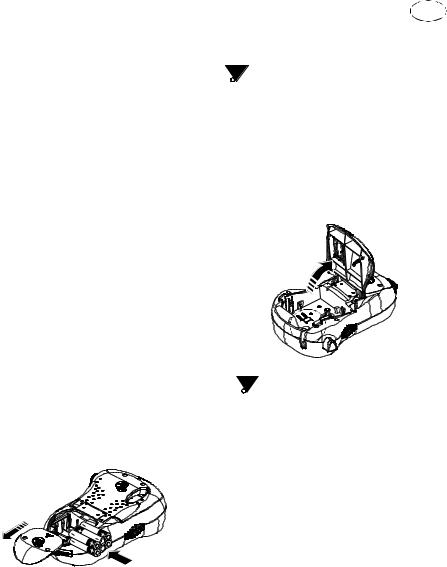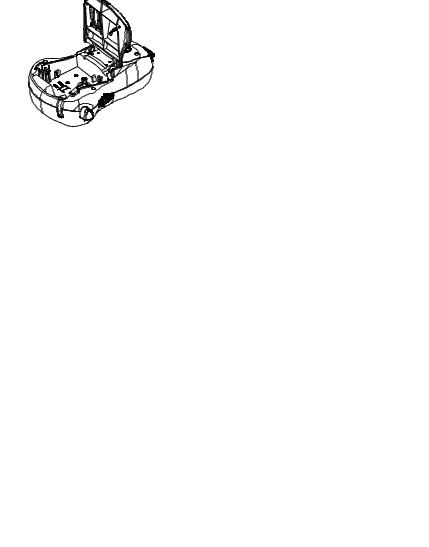Dymo LabelPoint 150 User Manual

About Your New Labelmaker
With your DYMO LabelPOINT™ 150 labelmaker, you can create a wide variety of high-quality, selfadhesive labels. You can choose to print your labels in many different sizes and styles. The labelmaker uses DYMO D1 tape cassettes in widths of 9 mm (3/8”) and 12 mm (1/2”). Tape cassettes are also available in a wide range of colors.
Visit www.dymo.com for information on obtaining labels and accessories for your labelmaker.
Warranty Registration
Please complete the warranty registration card and return it to the appropriate customer service address within seven days. Visit www.dymo.com for details.
Getting Started
Follow the instructions in this section to print your first label.
Connecting the Power
The labelmaker is powered by six AAA batteries. To save power, the labelmaker will automatically turn off after two minutes of inactivity.
To insert the batteries
1.Remove the battery compartment cover. See Figure 2.
Figure 2
2. Insert the batteries following the |
GB |
polarity markings (+ and –). |
|
3. Replace the battery compartment cover.
 Remove the batteries if the labelmaker will not be used for a long period of time.
Remove the batteries if the labelmaker will not be used for a long period of time.
Inserting the Tape Cassette
Your labelmaker comes with one tape cassette. Visit www.dymo.com for information about purchasing additional tape cassettes.
To insert the tape cassette
1.Press and release the tape cassette cover to open the label compartment. See Figure 3.
Remove cardboard insert
Figure 3
 The first time you use the labelmaker, remove the protective cardboard insert from between the print head and pinch roller. See Figure 3.
The first time you use the labelmaker, remove the protective cardboard insert from between the print head and pinch roller. See Figure 3.
2.Make sure the tape and ribbon are taut across the mouth of the cassette and that the tape passes between the guideposts. If necessary, turn the spool clockwise to tighten the ribbon.
3.Insert the cassette with the tape and ribbon positioned between the print head and pinch roller. See Figure 4.
3

CLICK!
Figure 4
4.Press firmly until cassette clicks into place.
5.Close the tape cassette cover and press Ato turn on the power.
Selecting a Language
You can select from a number of different language options. By default, the language is set to English. The language option you choose determines the default units of measure (inches or millimeters) and the character set that is available.
To select a language
1.Press Language .
2.Use the arrow keys to select the language you want and press ok .
Printing Your First Label
You are now ready to print your first label.
To print a label
1.Enter text to create a simple label.
2.Press Print .
3.Use the cutter lever to cut the label. Congratulations! You have printed your first label. Continue reading to learn more about the options available for creating labels.
Getting to Know the Labelmaker
Become familiar with the location of the feature and function keys on your labelmaker. Refer to
Figure 1. The following sections describe each feature in detail.
Power
The Abutton turns the power on and off. After two minutes of no activity, the power is switched off automatically. The last label created is remembered and displayed when the power is turned back on. The previously selected style settings are also restored.
You can also use the Abutton to cancel printing and return to edit mode.
LCD Display
The labelmaker’s LCD display shows a row of thirteen characters. However, you can enter up to 99 characters and spaces.
The display is similar to a window that scrolls across the text. (See Figure 5.) The number of characters actually displayed can vary due to proportional spacing.
The quick brrown ffox jjumps over the lazy dog.
Figure 5
In addition, feature indicators appear on the display to let you know when a feature is selected. See Figure 6.
Font |
Style |
Box/ |
Align/ |
Scroll |
Underline Justify |
bar |
|||
Fixed length 

# of copies 
 CAPS mode
CAPS mode 


Figure 6
4

CAPS Mode
The #key toggles capitalization on and off. When CAPS mode is turned on, the CAPS mode indicator is shown on the display and all letters that you enter will be capitalized. The default setting is CAPS mode on. When CAPS mode is off, all letters entered appear in lower case.
Shift Key
The 8key, when used in combination with an alphabet key, changes the case of the selected letter. When used in combination with number keys or function keys, the 8key selects the alternate function shown on the key. For example, when you press 0, the character to the left of the cursor is deleted; however, when you press 8+ 0 together, the entire label text and formatting is deleted and the display is ready for you to type a new label.
Space Bar
The Vkey inserts one or more blank spaces in your text.
Backspace
The 0key removes the character to the left of the cursor. Pressing 8+ 0clears all label text and formatting.
Navigation Keys
You can review and edit your label using the left and right arrow keys. Using 8with the left or right arrows moves the cursor to the beginning or end of the label text.
You can navigate through menu selections using the up and down arrow keys, and then press ok to make a selection.
Cancel
The C key allows you to exit from a menu without making a selection or to cancel an action.
key allows you to exit from a menu without making a selection or to cancel an action.
Return Key
The 7key inserts a new line on your label.
Extra Key
The Extra key displays Units, Copies, Preview, and Print Contrast submenus. These features are described later in this User Guide.
Formatting Your Label
You can choose from a number of formatting options to enhance the appearance of your labels.
 The labelmaker remembers the last selection made so that each time you enter one of the feature menus described in this section, you are positioned at the last item selected from that menu.
The labelmaker remembers the last selection made so that each time you enter one of the feature menus described in this section, you are positioned at the last item selected from that menu.
Changing the Font
Three fonts are available for your labels: Arial Narrow, Normal, and Wide.
When you select a font, that font applies to all characters on a page.
To set the font
1.Press the Xkey.
2.Use the arrow keys to move to the desired font and then press ok .
.
5
